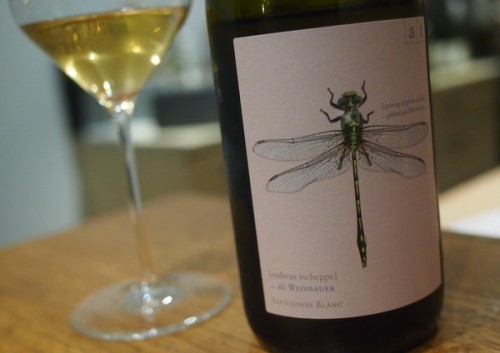
This is quite special. It’s a Sauvignon Blanc from Sudsteiermark (south Styria) in Austria, made by Andreas Tscheppe. He’s one of a group of five producers working biodynamically in this pretty region, and I was introduced to his wines by Doug Wregg of Les Caves de Pyrene. Doug had just visited the region, and was full of enthusiasm for Tscheppe. ‘I’ve not seen a vineyard so full of life,’ he told me. It’s 500 m up, and full of wild herbs, grass and bare stones.
Tscheppe Sauvignon Blanc Grüne Libelle 2012 Sudsteiermark, Austria
13.5% alcohol. This translates as ‘green dragonfly’, and it’s fermented in used 500 litre barrels with indigenous yeasts. It spends 2 years in barrel and then the same time in bottle before release. Amazingly textured, pure and mineral with dense nuts, apples and a bit of spice. There’s a lovely spicy mineral core to this wine as well as a hint of nice reduction. Such a lovely, rounded yet precise wine. Amazing stuff. 94/100 (UK agent Les Caves de Pyrene)
Find this wine with wine-searcher.com
7 Comments on Tscheppe Green Dragonfly Sauvignon Blanc, amazing Austrian wine
What’s the point of making a SB wine where you kill all the varietal aromas related to thiols molecules to replace that with oxidized aromas you can have with other white varietals? What is the impact of wild yeast on a wine exposed to so much oxygen? There is nothing natural there. Just the human decision to make an “oxidative” style that kills a lot of the true nature of what this wine could have been.
@Claude> Well, wine itself is, you know, a human decision. There’s nothing wrong with experimentation and trying new techniques and effects in wine making if the result is great!
Each decision from the winemaker, whatever the chateau, the grapes or the maturation techniques, is a human decision, made consciously in order to reach a goal, a taste, a texture.
To be fair, I haven’t tried this specific wine, so I couldn’t comment on it specifically, but as a general rule I believe that winemakers are welcome to try and do their best with their grapes and their ideas (as long as it doesn’t involve something potentially dangerous for the consumer of course).
Then again, obviously, not all ideas are worthy, and it may be that the end result isn’t up to expectations; but then, hopefully things will get better the year after 😉
I was also fortunate enough to taste Andreas Tscheppe’s wines at his beautiful vineyard in Südsteiermark, including the Sauvignon Blanc “Grüne Libelle”, and I completely agree with Jamie Goode: this wine (and Tscheppe’s other wines) is remarkable, unique and full of character, a wine to ponder. If you want a Sauvignon Blanc that tastes more or less like all the others from around the world, look elsewhere. There’s no shortage.
I personally find larger barrel formats to be reasonably reductive warranting longer barrel time. I enjoy the character of warmer barrel fermentation with the intention of blowing off the overt varietal characters to reveal more of the core character of the site. When handled this way with less fear of oxidation, embracing natural acidity & extended lees ageing one can see the real potential of this variety to not only be delicious but also ageworthy with less demand for sulphites. I can’t wait to try this wine and add it to my ever growing list of impressive Austrian whites.
Lance and Gregory – you’re bang on the mark with your assessments. The wine really communicates its sense of place over the classic (cliched) under-ripe faux-Sauvignon varietal character. And that place is quite remarkable. The work done in the vineyards produces grapes of terrific aromatic intensity. The reduction initally protects the wine before blowing off gently. I have had this wine open for three weeks and it continues to improve. It reminds me of the great “slow-cooked” Friuli whites with their locked-in minerality and thrilling energy. This “Sauvignon” should also be served in a grand Burgundy balloon to best enable the wine to bloom. And if you think it is oxidative (are all wines fermented in large format barrels oxidative, by definition?) just look at the colour in the glass.
I tried this at a natural wine tasting in London earlier this year and it is quite extraordinary and confounding at the same time. It smells of bonfires but that smokiness does not quite translate onto the tongue. It will challenge all preconceptions of what you think it should a sauvignon should taste like. I loved it!
True, it’s a special place there, and in total – Styria is beautiful and offers so much hidden treasures!
best from Styria,
Gottfried